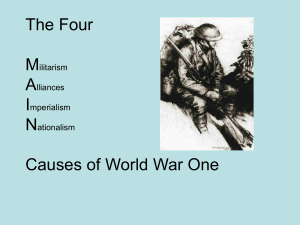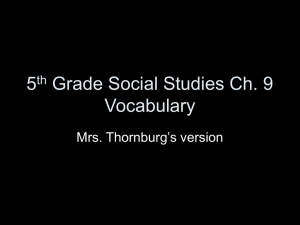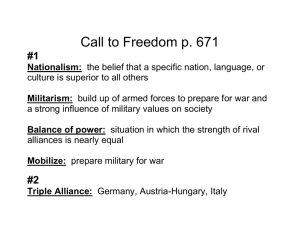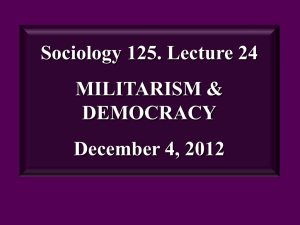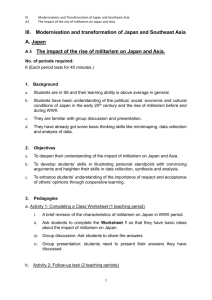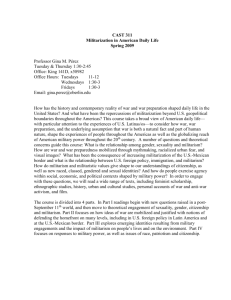Modernisation and transformation of Japan
advertisement
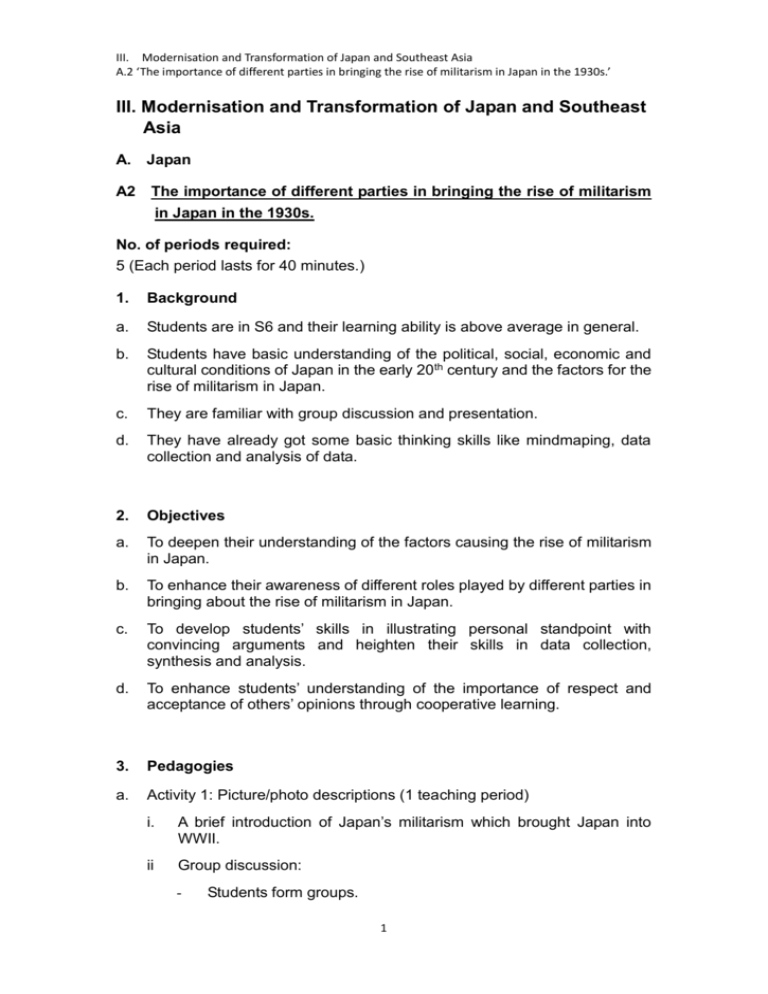
III. Modernisation and Transformation of Japan and Southeast Asia A.2 ‘The importance of different parties in bringing the rise of militarism in Japan in the 1930s.’ III. Modernisation and Transformation of Japan and Southeast Asia A. Japan A2 The importance of different parties in bringing the rise of militarism in Japan in the 1930s. No. of periods required: 5 (Each period lasts for 40 minutes.) 1. Background a. Students are in S6 and their learning ability is above average in general. b. Students have basic understanding of the political, social, economic and cultural conditions of Japan in the early 20th century and the factors for the rise of militarism in Japan. c. They are familiar with group discussion and presentation. d. They have already got some basic thinking skills like mindmaping, data collection and analysis of data. 2. Objectives a. To deepen their understanding of the factors causing the rise of militarism in Japan. b. To enhance their awareness of different roles played by different parties in bringing about the rise of militarism in Japan. c. To develop students’ skills in illustrating personal standpoint with convincing arguments and heighten their skills in data collection, synthesis and analysis. d. To enhance students’ understanding of the importance of respect and acceptance of others’ opinions through cooperative learning. 3. Pedagogies a. Activity 1: Picture/photo descriptions (1 teaching period) i. A brief introduction of Japan’s militarism which brought Japan into WWII. ii Group discussion: - Students form groups. 1 III. Modernisation and Transformation of Japan and Southeast Asia A.2 ‘The importance of different parties in bringing the rise of militarism in Japan in the 1930s.’ - Each group is given a photo or cartoon about Japan’s militarism (See Worksheet 1). Teacher may get other relevant pictures from the following sources: http://bbs.tiexue.net/post2_3346052_1.html http://big5.ifeng.com/gate/big5/news.ifeng.com/history/zhongguojin daishi/detail_2010_08/03/1878400_0.shtml - b. Each group should find out the characteristics of Japan’s militarism shown in the pictures/photos. iii. Group presentation: - Show the pictures/photos in the visualiser so that all students can view them easily. - Students present by groups the characteristics of Japan’s militarism shown in the pictures/photos. Activity 2: Role Play (2 teaching periods) i. Teachers need to give background information about the rise of Japan’s militarism before introducing the role play activity. ii. Students are divided into groups. Each group is assigned to present ONE of the following roles which helped bringing about the rise of militarism in Japan: iii. iv. v. vi. c. Government officials Genro Businessmen Peasants Workers Militarists Foreign powers (the US, Germany or Italy) Before presentation, students need to search more information about the assigned roles in bringing about the rise of militarism in Japan. After searching information and completing the Worksheet 2, they need to present how different parties brought about the rise of militarism in Japan. Teachers are advised to choose the best presentation group and give the prize for award. Conclusion by the teacher Activty 3: Follow-up Task (2 teaching periods) i. Mindmapping task (See Worksheet 3A): students are to draw a mindmap to summarise the roles of different parties in bringing about the rise of militarism in Japan. 2 III. Modernisation and Transformation of Japan and Southeast Asia A.2 ‘The importance of different parties in bringing the rise of militarism in Japan in the 1930s.’ ii. Essay writing task: students are asked to write an essay to evaluate the role of different parties in the rise of militarism in Japan. The question of the essay is ‘Assess the importance of party government in leading to the rise of militarism in Japan.’ iii. Teachers are advised to guide students to study the assessment criteria and complete the essay based on the criteria so that they have a clear understanding of the level marking of essay writing. (See Worksheet 3B) iv. Teachers are advised to choose some students to present their essays in order to check the learning outcome of students. 4. Expected outcome/difficulties a. Students will have deeper understanding of the factors leading to the rise of militarism in Japan. b. Students will be aware of the roles played by different parties in bringing about the rise of militarism. c. Students will have better skills of illustrating personal standpoints with convincing arguments, data collection, synthesis and analysis. d. Students will have deeper understanding of the importance of respect and acceptance of others’ opinions through cooperative learning. e. Students may point out the importance of some parties but fail to highlight the greatest importance of a certain party and the relative importance of the others. 3 III. Modernisation and Transformation of Japan and Southeast Asia A.2 ‘The importance of different parties in bringing the rise of militarism in Japan in the 1930s.’ Worksheet 1 Picture/Photo Description Find out the characteristics of Japan’s militarism shown in the picture below. Source: rarebooksinjapan.com/JAPANESEMILITARISM.htm 4 III. Modernisation and Transformation of Japan and Southeast Asia A.2 ‘The importance of different parties in bringing the rise of militarism in Japan in the 1930s.’ Worksheet 2 Role-play How did the role assigned to you bring about the rise of militarism in Japan? Write down the key points in the form below. Role: _______________________ Answers for reference: Government officials: promoters of spreading militarism Genro: supporters of expansionist ideas raised by the militarists opponents to expansionist ideas raised by the militarists Businessmen: supporters of militarism, provided fund to the militarists, for getting raw materials and overseas markets through expansion Peasants: supporters/ followers to support expansionist ideas raised by militarists Workers supporters/ followers to support expansionist ideas raised by militarists Militarists: promoters to spread expansionist ideas raised by the militarists supporters to expansionist ideas raised by the militarists Foreign powers (the US, Germany & Italy): Germany and Italy: inspirer to expand due to successful expansion US: facilitator due to her isolation policy 5 III. Modernisation and Transformation of Japan and Southeast Asia A.2 ‘The importance of different parties in bringing the rise of militarism in Japan in the 1930s.’ Worksheet 3A Mindmapping Draw a mindmap to summarize different roles in bringing about the rise of militarism in Japan. Guidelines for reference: the mindmap should include the following Topic/theme: roles in the rise of militarism in Japan Sub-topics: government officials, genro, businessmen, peasants: supporters/ followers, workers, militarists, foreign powers (the US, Germany & Italy) Elaboration of each sub-topic 6 III. Modernisation and Transformation of Japan and Southeast Asia A.2 ‘The importance of different parties in bringing the rise of militarism in Japan in the 1930s.’ Worksheet 3B Marking Criteria for the Essay Assess the importance of party government in leading to the rise of militarism in Japan. Criteria Grade (Max. 15) -Coherent presentation with balanced evaluation on the role and importance of party government relative to the others in leading to the rise of militarism in Japan during the 1930s, supported by solid historical examples that cover considerably the period. -Clearly expressed, persuasive, and coherent, showing critical and analytical judgment A 14-15 -Shows good understanding of the question, able to provide a generally balanced evaluation on the role and importance of party government relative to the others in leding to the rise of militarism in Japan during the 1930s. Historical examples cover a considerable period. - Clearly expressed and logically presented, showing some success in analyzing relevant issues and/or in presenting a substantiated argument. B 12-13 -Shows good understanding of the question, able to provide a gnerally balanced evaluation on the role and importance of party government (relative to the others) in leding to the rise of militarism in Japan during the 1930s; but the discussion is obviously lopsided to the role of party government, and/or contains underdeveloped arguments. Examples cover a good part of the period in question. C 10-11 -Shows general understanding of the question, and the discussion focuses merely on the role of party government; or attempts to tackle both but marrred by rough arguments. - Basically relevant and accurate contents, but lacking in balance. D 8-9 -Shows awareness of the question, and the discussion focuses merely on the role of party government, marred by rough arguments and overgeneralization; - Shows some attempt to argue and/or to analyse, but being marred by inconsistencies and unduly narrative or descriptive approach. E 6-7 7 III. Modernisation and Transformation of Japan and Southeast Asia A.2 ‘The importance of different parties in bringing the rise of militarism in Japan in the 1930s.’ - Primarily a narration of the development of the rise of militarism in Japan during the 1930s, without obvious attempt to evaluate the role of party government (relative to the others) in leading to the rise of militarism in Japan during the 1930s. E/F 5 - A general discussion of the development of the rise of militarism in Japan during the 1930s, and/or shows no efforts of evaluating the role of party government(relative to the others) in leading to the rise of militarism in Japan during the 1930s. - Containing few relevant and important facts; poorly organised and barely understandable, with conspicuous mistakes in writing or spelling personal and place names. F 3-4 Adapted from “Sample Paper and marking scheme reference for HKDSE History 2009” with permission of the Hong Kong Examinations and Assessment Authority. 8

